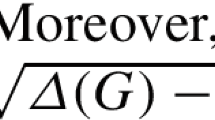Abstract.
Heilmann et Lieb ont introduit le polynôme de couplage μ(G, x) d’un graphe G = (V, E). Nous prolongeons leur définition en munissant chaque sommet de G d’une forme linéaire N-dimensionnelle (ou bien d’un vecteur) et chaque arête d’une forme symétrique bilinéaire. On attache donc à tout r-couplage de G le produit des formes linéaires des sommets qui ne sont pas saturés par le couplage, multiplié par le produit des poids des r arêtes du couplage, où le poids d’une arête est la valeur de sa forme évaluée sur les deux vecteurs de ses extrémités. En multipliant par (−1)r et en sommant sur tous les couplages, nous obtenons notre polynôme de couplage N-dimensionnel. Si N = 1, le théorème principal de l’article de Heilmann et Lieb affirme que tous les zéros de μ(G, x) sont réels. Si N = 2, cependant, nous avons trouvé des graphes exceptionnels où il n’y a aucun zéro réel, même si chaque arête est munie du produit scalaire canonique. Toutefois, la théorie de la dualité développée dans [La1] reste valable en N dimensions. Elle donne notamment une nouvelle interprétation à la transformation de Bargmann–Segal, aux diagrammes de Feynman et aux produits de Wick.
Heilmann and Lieb have introduced the matching polynomial μ(G, x) of a graph G = (V, E). We extend their definition by associating to every vertex of G an N-dimensional linear form (or a vector) and to every edge a symmetric bilinear form. For every r-matching of G we define its weight as the product of the linear forms of the vertices not covered by the matching, multiplied by the product of the weights of the r edges of the matching, where the weight of an edge is the value of its form evaluated at the two vectors of its end points. Multiplying by (−1)r and summing over all matchings, we get our N-dimensional matching polynomial. If N = 1, the Heilmann–Lieb theorem affirms that all zeroes of μ(G, x) are real. If N = 2, however, there are exceptional graphs without any real zero at all, even if the canonical scalar product is associated to every edge. Nevertheless, the duality theory developed in [La1] remains valid in N dimensions. In particular, it brings new light to the Bargmann–Segal transform, to the Feynman diagrams, and to the Wick products.
Similar content being viewed by others
Author information
Authors and Affiliations
Corresponding author
Additional information
Received: February 2004 Revision: July 2004 Accepted: August 2004
Rights and permissions
About this article
Cite this article
Lass, B. The N-dimensional matching polynomial. GAFA, Geom. funct. anal. 15, 453–475 (2005). https://doi.org/10.1007/s00039-005-0512-0
Issue Date:
DOI: https://doi.org/10.1007/s00039-005-0512-0




